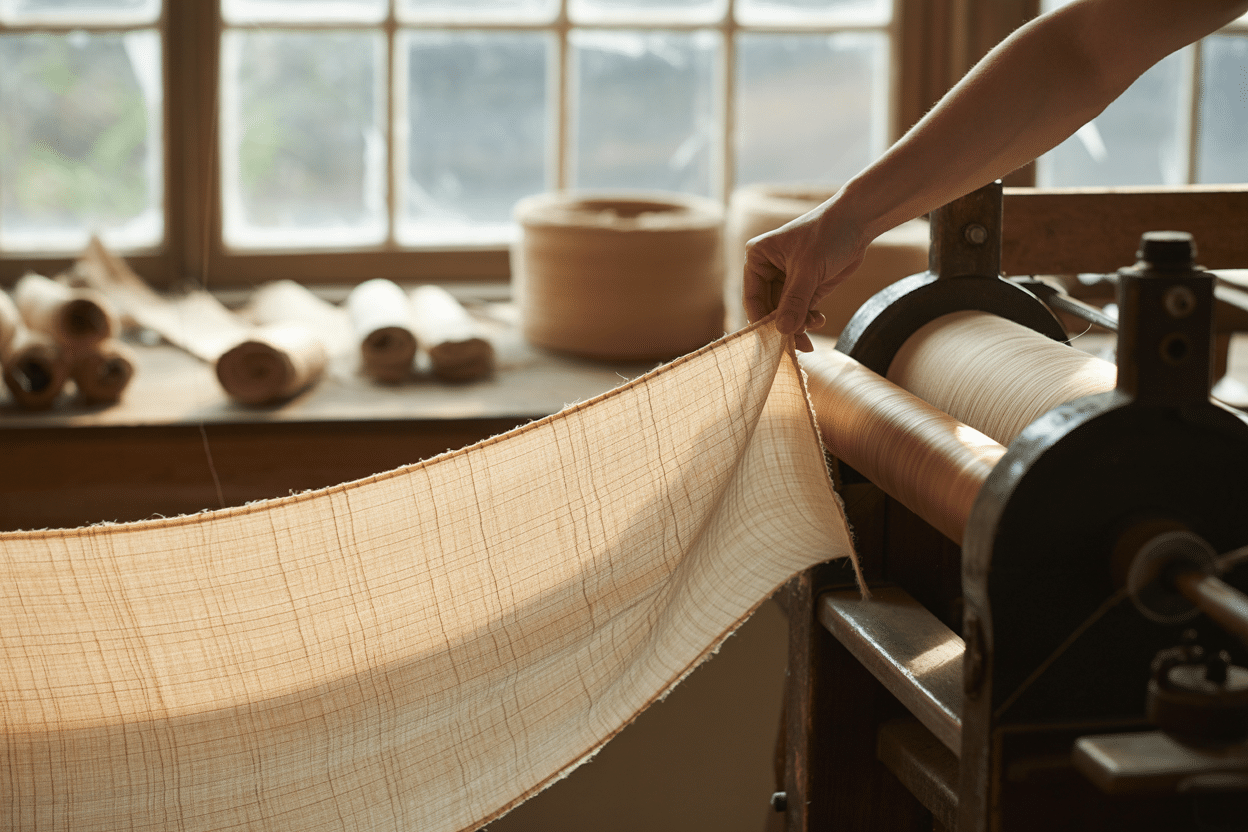You’ve probably never heard of ramie. And that’s exactly how this ancient textile likes it.
While cotton and linen hog the spotlight, ramie has been quietly infiltrating wardrobes for over 6,000 years. This fiber operates in the shadows, stronger than cotton, cooler than linen, yet somehow staying off most people’s radar.
But the fashion industry doesn’t want you to know that Ramie may be your closet’s best-kept secret.
Today, we’re blowing Ramie’s cover. Time to meet the fabric that’s been hiding in plain sight.
What is Ramie Fabric?
Ramie is a natural fiber from the stalks of the Boehmeria nivea plant, part of the nettle family. Biodegradable and renewable, it’s a sustainable alternative to synthetic fabrics.
With its slubby, linen-like texture, ramie is often called Chinese Linen, China Grass, or Grass Cloth.
Used for over 6,000 years, ramie is one of the oldest known textiles. Ancient Chinese dynasties wove it into clothing and home goods, calling it “Xiabu” (Summer Fabric).
It was also used in Egyptian burial shrouds and prized in medieval Europe for fine home textiles, proof of its lasting cultural and practical value.
How Ramie Fabric is Made

The process of turning ramie plants into wearable fabric involves several careful steps that have been refined over thousands of years.
Processing
- Cultivation: Ramie plants are grown in warm, humid regions, maturing in about 6 to 8 months.
- Harvesting: Stalks are cut entirely when the plant is about to flower, as fibers are at their strongest.
- Decortication: The outer bark is stripped away to expose the fibers in the inner part.
- Degumming: Fibers undergo chemical treatment to remove natural gums and pectins, leaving pure cellulose strands.
Manufacturing
- Blending: Ramie is often combined with other natural fibers, such as cotton or viscose, to create various fabric qualities.
- Plying: Multiple ramie fibers are twisted together to create stronger, more durable yarns.
- Spinning and Weaving: Processed fibers are spun into yarns and woven into textiles.
- Natural Dyeing: Easy to dye, ramie can be colored using natural dyes from plants and minerals.
- Finishing: Fabric is bleached, dyed, or printed to enhance its natural sheen and texture.
Core Characteristics
Ramie is a bast fiber that comes from the inner bark of the Boehmeria nivea plant. When you think of what ramie fabric is, think of it like cotton and linen – it’s primarily composed of cellulose.
1. Strength Under Cover: Eight times stronger than cotton. This fiber doesn’t break under pressure, literally. It’s the heavyweight champion of natural textiles.
2. The Cool Operator: Hollow fibers create natural air conditioning. Your skin stays dry, and you stay comfortable. Perfect for undercover summer operations.
3. Stealth Transformation: Starts rough, gets silky with each wash. It’s like the fabric reveals its true identity over time.
4. Natural Armor: Built-in antimicrobial protection. Resists UV rays and mold without chemical backup. Standard-issue defense system.
5. Shape-Shifter: Holds its form like a pro. No shrinking, stretching, or losing composure under stress.
6. Low-Maintenance Agent: Machine washable and quick-drying. This operative doesn’t need babysitting.
The Many Uses of Ramie Fabric
Now that we know what ramie fabric is, it’s easy to see why it’s considered such a versatile material.
With its strength, breathability, and natural luster, ramie adapts beautifully to a wide variety of applications, from fashion and home décor to industrial and artistic uses.
Summer Clothing and Apparel
Ramie is ideal for lightweight summer garments such as shirts, dresses, and trousers. Its breathable nature makes it perfect for warm and humid conditions.
Many sustainable fashion brands choose ramie to create comfortable, long-lasting clothing that keeps the body cool.
Home Textiles and Furnishings
In home décor, ramie fibers are woven into durable tablecloths, napkins, pillowcases, and blankets.
They are also used for curtains, cushion covers, and other furnishings, where their natural texture adds elegance while remaining practical and sustainable.
Industrial Applications
Thanks to its exceptional strength, ramie is widely used in ropes, canvas, and packaging materials.
It is also utilized in industrial papers and filtration products, as the fibers become even stronger when wet, making ramie well-suited for heavy-duty applications.
Cultural and Artistic Projects
In traditional Chinese crafts, ramie has long been used for making paper for calligraphy and painting.
Its durability and excellent ink absorption make it a favorite among artists and craftspeople, ensuring works created on ramie-based paper last for years.
Household Utility Items
Because it can withstand high washing temperatures and is naturally resistant to stains, ramie is perfect for laundry bags, aprons, and toiletry bags.
Its unique property of strengthening when wet makes it especially useful for household items that face frequent use and cleaning.
Accessories and Fashion Items
Ramie’s slight natural sheen gives it a refined finish, making it an excellent material for scarves, handbags, and other accessories.
These pieces are both functional and stylish, offering a natural, eco-friendly touch to everyday fashion.
Ramie Material vs. Other Fabrics
Ramie combines the best of all worlds. It beats most fabrics in durability and material structure. Here’s how:
1. Ramie vs Linen
Ramie has longer, smoother fibers than linen, which tends to be shorter and coarser in texture.
It also offers greater strength and better resistance to wear and tear, making it a more durable option for long-term use.
2. Ramie vs Hemp
Ramie fibers are naturally white, so they don’t need bleaching like hemp often does to achieve lighter tones.
The texture of ramie is smoother and less rough, which can feel more comfortable on the skin.
While both are strong plant-based fabrics, ramie has a finer, more refined finish that suits lightweight clothing and household textiles.
3. Ramie vs Cotton
Ramie is significantly stronger than cotton and holds its shape well over time. It doesn’t rely on heavy use of pesticides or fertilizers, unlike cotton, which makes it a more eco-friendly choice.
The fibers are also more resistant to mildew and wrinkles.
4. Ramie vs Silk
Unlike silk, ramie comes entirely from plants, making it a good fit for vegan lifestyles.
It’s also much tougher. Ramie holds up better to washing, heat, and daily use.
While it doesn’t have the same sheen as silk, ramie material offers a similar smoothness with less fuss.
How to Care for Ramie Fabric

Caring for ramie is easier than you might think. You can either hand-wash or machine-wash it, but always use cold water (under 100°F) to prevent colors from fading.
Choose neutral detergent and avoid alkaline substances – baby shampoo works great if you’re unsure.
Skip the spin cycle since violent tumbling causes too much friction. Instead, gently wring it out and air dry it flat to prevent wrinkles.
When ironing, do it while the fabric is almost dry with the inside facing out. Store your ramie items flat in a breathable place to maintain their shape.
Final Thought
Now you know the whole story of ramie fabric and what Ramie Fabric is. This natural fiber offers something special: the strength of hemp, the breathability of linen, and the luster of silk, all in one plant-based material.
That’s why ramie fabric deserves attention in today’s world, where we’re all looking for better, more sustainable choices.
So what’s next? Start noticing ramie on clothing labels when you shop. Try a ramie shirt or dress for summer and feel the difference yourself.
Have you spotted Ramie in stores yet?


